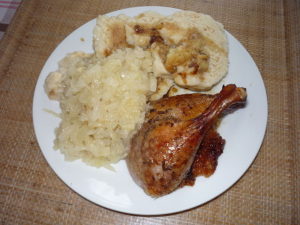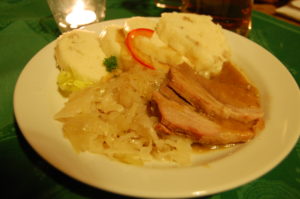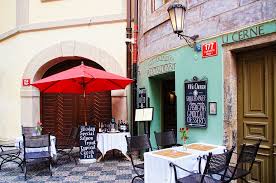- Your Online Prague Guide by locals – Follow us:
CZECH CUISINE

Czech National Bank building
September 17, 2016
THE PRAGUE PUBLIC TRANSPORT
October 8, 2016CZECH CUISINE
Duck baked on honey with fresh homemade cabbage, fried onions and Karlsbad
dumplings, maybe the most typical meal of Czech cuisine.

Baked duck with cabbage and Carlsbad dumplings
Czechs enjoy the mystical. Perhaps that is one of the reasons, why Czech
cuisine is not so easily traceable. Some people claim that Czech cuisine is
actually mostly Austrian. Those would serve you a Vienese schnitzel for
lunch.

Schnitzel with potatoes salad
Others see it as primary German. Expect a baked pork with fluffy
dumplings and sour cabbage from those.

Baked pork with homemade cabbage and dumplings
A hungarian influance can not be underestimated, others will cry. A Hungarian goulash with a rich dose of paprika will be their choice for the morning after a late night out.

Hungarian goulash with dumplings and onion
And what about the peasant meals prepared from whatever local climat allows to grow? Potatoes, grains, apples, carp fishes in the Southern Bohemia ponds,
trouts in the mountain streams, game in the deep forrests and variety of
edible mushrooms. Or Gypsies and their simple potlocks. Have not their
bohemian lifestyle, according to one of the many stories, even given a name
to a major part of the Czech republic – Bohemia?! One must not forget the
Jews with their taste for garlic which can be tracked in Czech cooking
pots, yet others will remind us. Russians who were taught by short summers
the art of preservation. And Slavs with their love for souring foods with
sour cream, lemon or vinegar. Which one is right? The answer seems to be:
All of them. Czech cuisine is following the geographical disposition of the
land. It is by right called the Heart of Europe.
A great shift in the Czech cuisine happened in the 17th century when the arousal of renesaince, alchemy and social changes pushed aside Arabic sweet and spicy influence and Czech cooking pots became salty and sour. Most of the restaurants serving the traditional Czech foods are located on the route outmarked by the tourist guides. But if you dare to leave the main road and merge into the mystical knots of the Prague streets you will find magical surprises awaiting you.

A cozy recess in Prague
When passing the National Theatre, cross the Bridge of
Legions (Most Legií) with a wonderful view of Prague Castle and many Vltava
islands. It will bring you to the Café Savoy (MAP: B4), traditional place
which was opened in 1893. Its unique atmosphere is also supported by a
remarkable interior dominated by a listed ceiling comparable with the best
works of Czech neo-Renaissance. This restaurant respects the best
traditions of Czech fine dining, artfully replacing sometimes heavy and too
rich elements in Czech meals with light and modern esprit (this philosophy
includes the prices, which are very friendly).
Try the genuine Prague ham or duck baked on honey with fresh homemade cabbage, fried onions and Karlsbad dumplings. And save some space for the delicious homebaked cakes and wonderful coffees. Do not worry, if you can not resist and eat more then normally – café Savoy is a great start for a pictoresque Malá Strana (Little Town) walk or a Petín hill hike to the Prague Castle.



